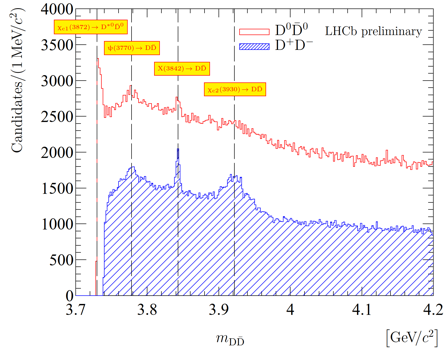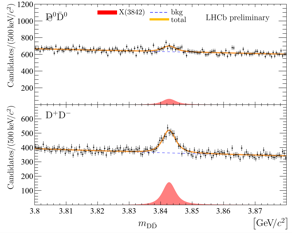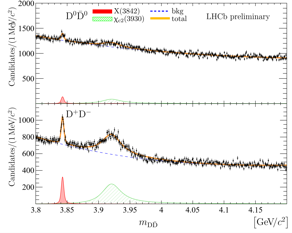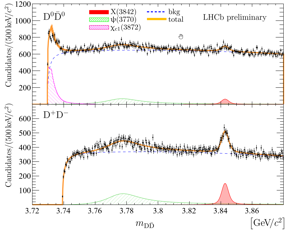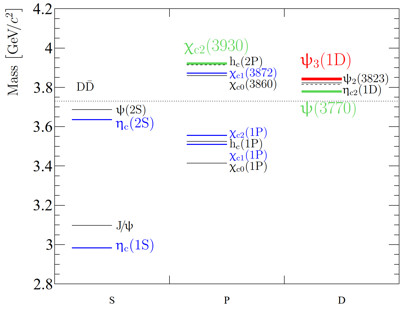… and study of near-threshold D0D0 spectroscopy.
[mX(3842) = 3842.72±0.16±0.12 MeV/c2; ΓX(3842) = 2.79±0.51±0.35 MeV ]
This week the LHCb Collaboration announced the discovery of a new particle made of a charm and anti-charm quark. The results, which were presented at the International Workshop “e+e– Collisions From Phi to Psi 2019″ held in Novosibirsk, are the first to make use of all the available data recorded by the LHCb experiment from 2011 to 2018, and also include precise measurements of the properties of two other so-called “charmonium” states.
The charmonium states are bound systems of a charm quark, c, and an anti-charm quark, c, held together by the strong nuclear force. Just like ordinary atoms, e.g. hydrogen, c and c quarks can be arranged in various quantum states with different angular momenta and spin configurations, giving rise to a spectrum of particles with different masses, all composed of the same fundamental quarks. In recent years there has been a resurgence of interest in charmonium spectroscopy following the discovery of states that do not fit into the conventional charmonium spectrum. It is sometimes difficult to conclude if a new discovered state is a previously unobserved charmonium state or an exotic particle composed e.g. of four quarks, such as a tetraquarks. Knowledge of the spectrum of conventional states is important to help identify exotic states: if all predicted conventional states are accounted for, we can be more confident that the remaining ones are exotic.
Charmonium states with mass smaller than twice the mass of a charm meson D cannot decay into a pair of charmed particles that each contain a charm c or an anticharm c quark. Instead, the states with higher masses can, and decay typically into charm meson pairs. LHCb physicists studied the decays of charmonium in D0D0 and D+D– meson pairs. The image above shows the corresponding invariant mass spectra. Several peaking structures can be clearly seen and are listed in the figure. The images below show fits to different regions of the mass spectra with models used to describe these structures as charmonium states emerging above the background. The narrow structure marked X(3842) in the image above represents the contribution of a new narrow charmonium state, observed for the first time by LHCb, with overwhelming statistical significance in both decay modes. The left image below shows a fit giving the mass of this state to be 3842.72±0.16±0.12 MeV/c2 and the natural width 2.79±0.51±0.35 MeV, where the first error is statistical and the second systematic. The observed mass and narrow natural width suggest the interpretation of the new state as the previously unobserved ψ3(1D) charmonium state. This represents the first spin-3 charmonium state observed. It is interesting to note that LHCb discovered in July 2014 another spin-3 state in the Ds meson system.
The other peaking structures visible in the images above represent prompt hadroproduction, seen for the first time, of the previously observed ψ(3770) and χc2(3930) states. The most precise measurements ever of the resonance parameters of these states were made. The low mass structure visible in the D0D0 invariant mass spectrum comes from the χc1(3872)→D∗0D0 decays followed by the D∗0→D0π0 or D∗0→D0γ decays, where the γ and the π0 are not detected.
The left image shows LHCb contribution to the knowledge of the charmonium spectrum. The newly discovered X(3842) state is marked in red as ψ3(1D). The two states, which new parameter measurements were announced at the conference, are marked in green. Other states, in which the most precise measurements comes from LHCb, are shown with blue lines. In particular, LHCb announced in September 2017 a very innovative measurement of the masses of the χc1 and χc2 charmonium mesons, performed for the first time by utilising the newly discovered decay χc1,2→μ+μ–J/ψ. Two not-yet discovered states hc(2P) and ηc2(1D) are shown with dashed lines. The DD threshold is indicated with dotted line.
Read more in the LHCb presentation, in the CERN news in English and in French and also in the LHCb paper.

